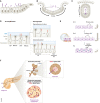Emerging principles of primary cilia dynamics in controlling tissue organization and function
- PMID: 37743763
- PMCID: PMC10620770
- DOI: 10.15252/embj.2023113891
Emerging principles of primary cilia dynamics in controlling tissue organization and function
Abstract
Primary cilia project from the surface of most vertebrate cells and are key in sensing extracellular signals and locally transducing this information into a cellular response. Recent findings show that primary cilia are not merely static organelles with a distinct lipid and protein composition. Instead, the function of primary cilia relies on the dynamic composition of molecules within the cilium, the context-dependent sensing and processing of extracellular stimuli, and cycles of assembly and disassembly in a cell- and tissue-specific manner. Thereby, primary cilia dynamically integrate different cellular inputs and control cell fate and function during tissue development. Here, we review the recently emerging concept of primary cilia dynamics in tissue development, organization, remodeling, and function.
Keywords: cilia dynamics; ciliary signaling; cilium disassembly; primary cilia; tissue organization.
© 2023 The Authors. Published under the terms of the CC BY NC ND 4.0 license.
Conflict of interest statement
The authors declare that they have no conflict of interest.
Figures



References
-
- Abraham SP, Nita A, Krejci P, Bosakova M (2022) Cilia kinases in skeletal development and homeostasis. Dev Dyn 251: 577–608 - PubMed
Publication types
MeSH terms
Grants and funding
LinkOut - more resources
Full Text Sources

